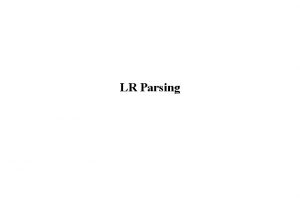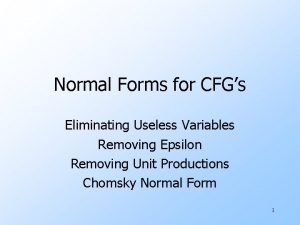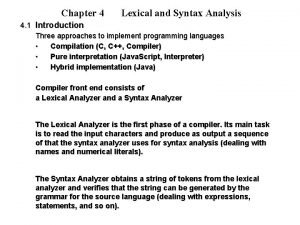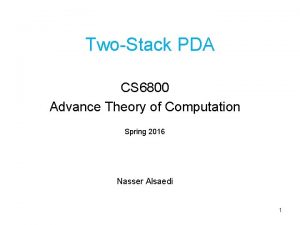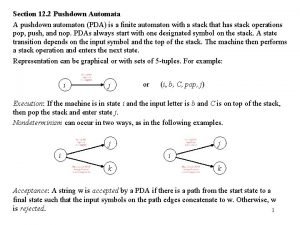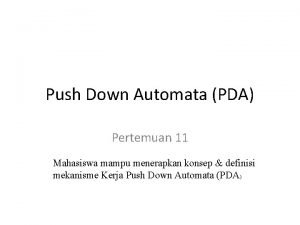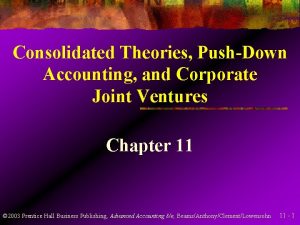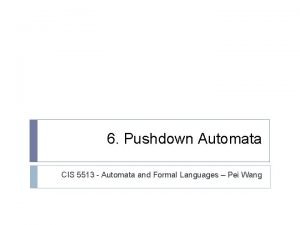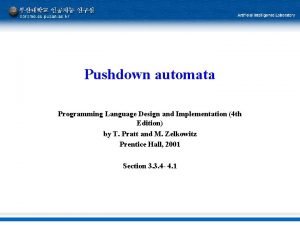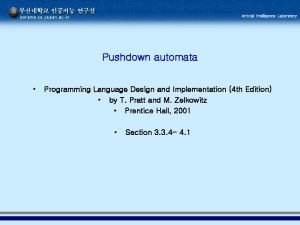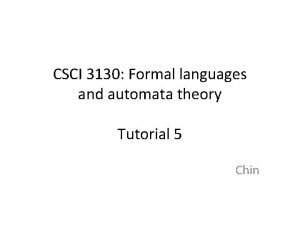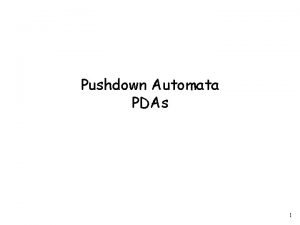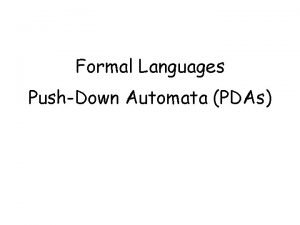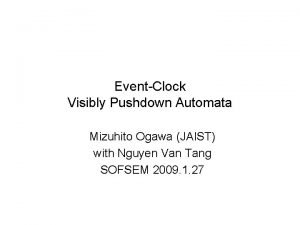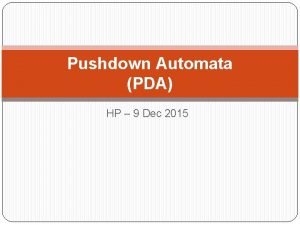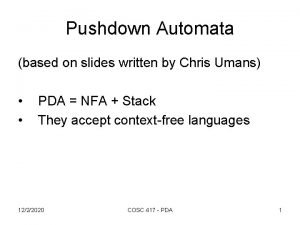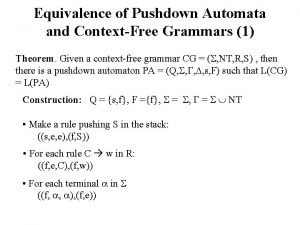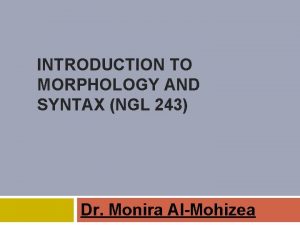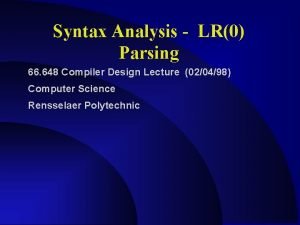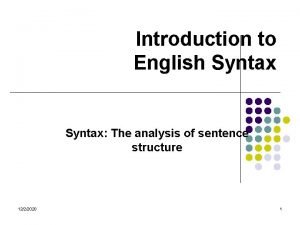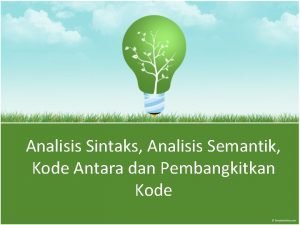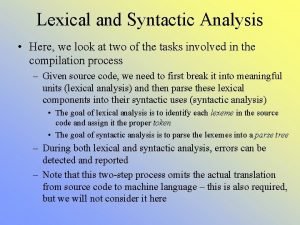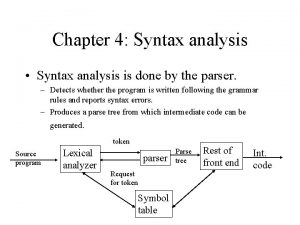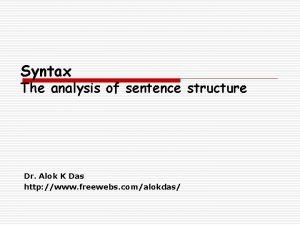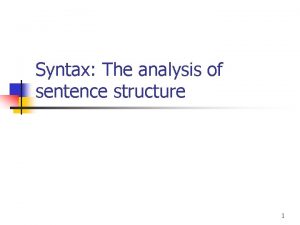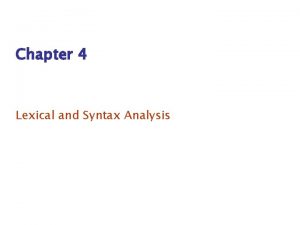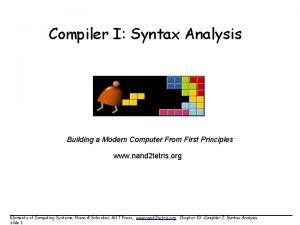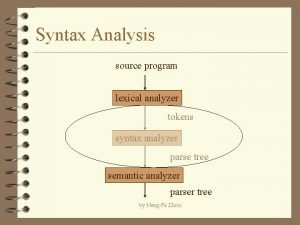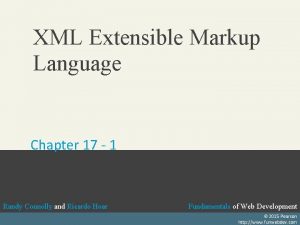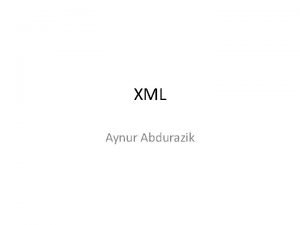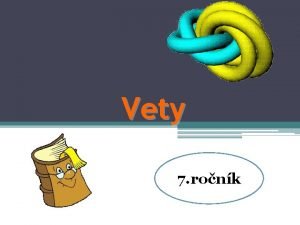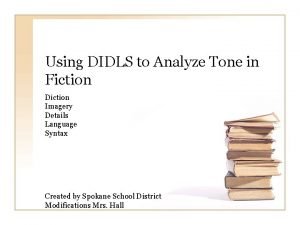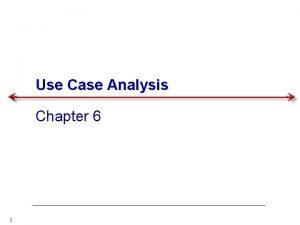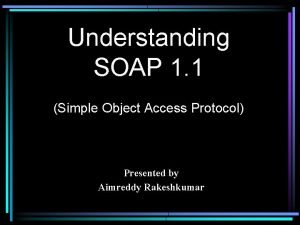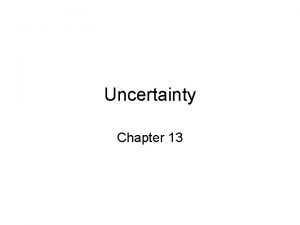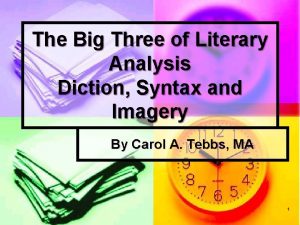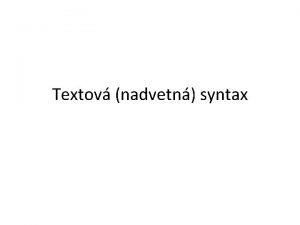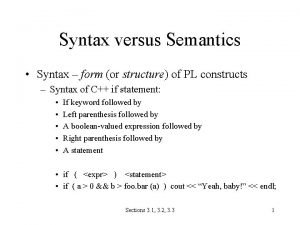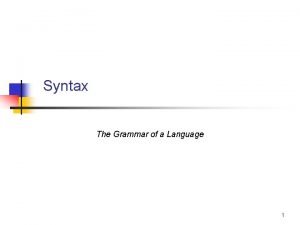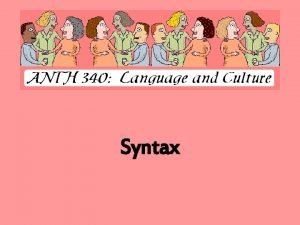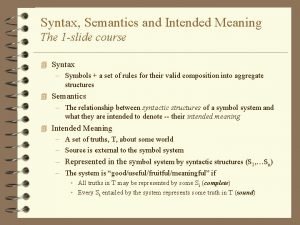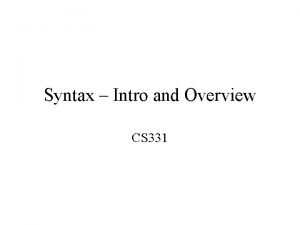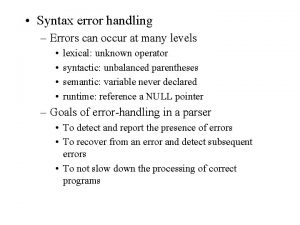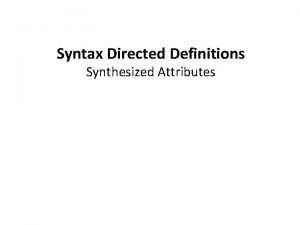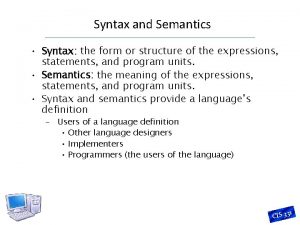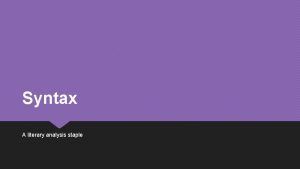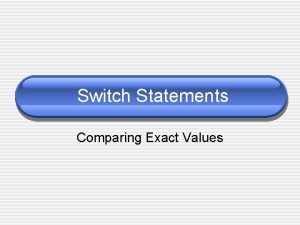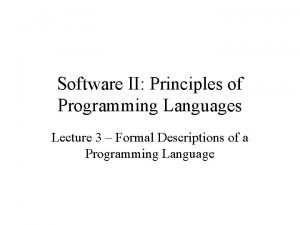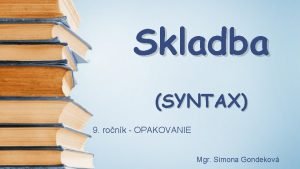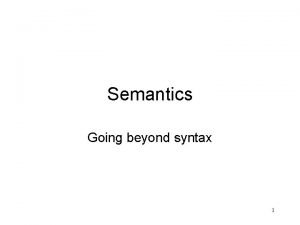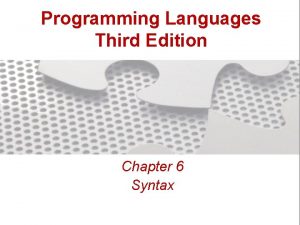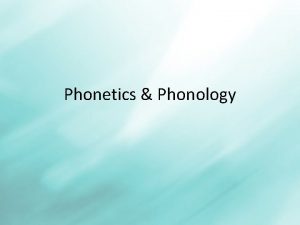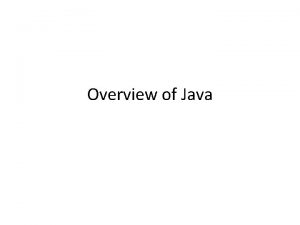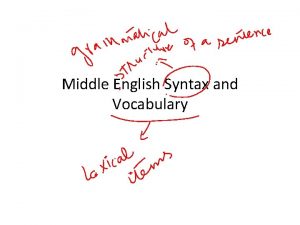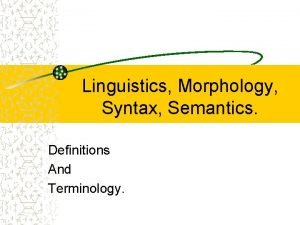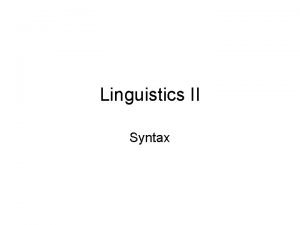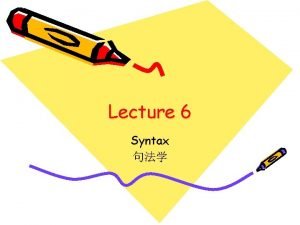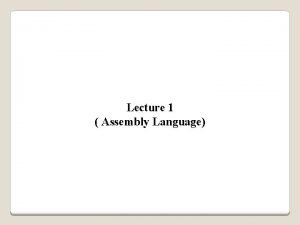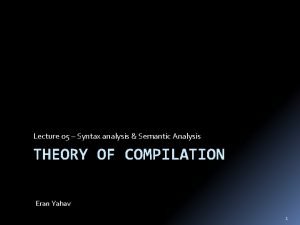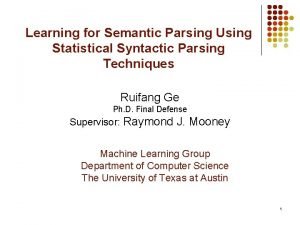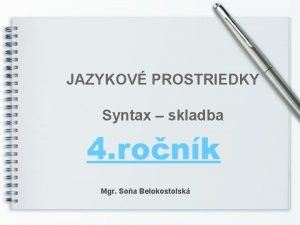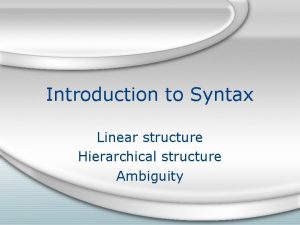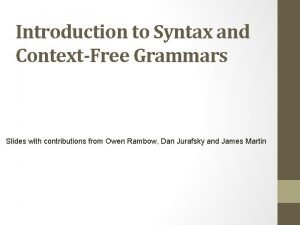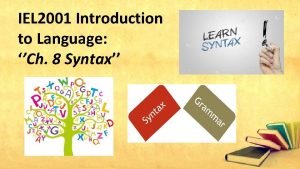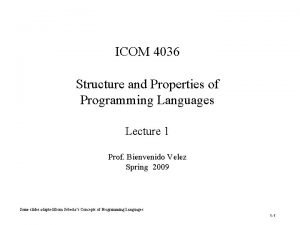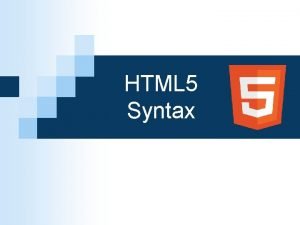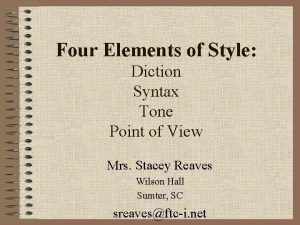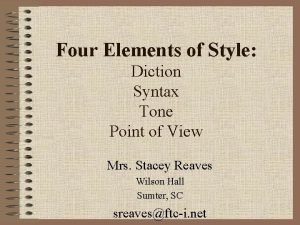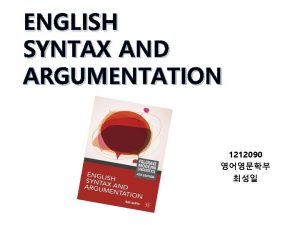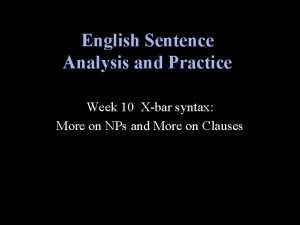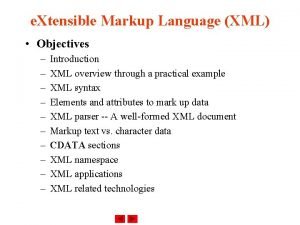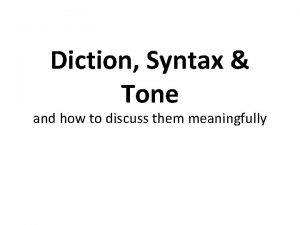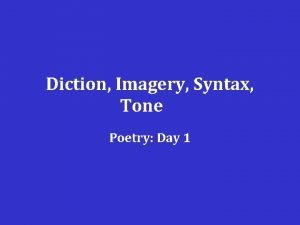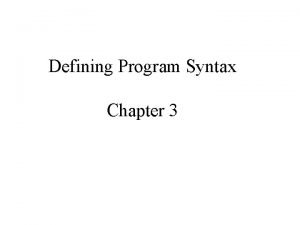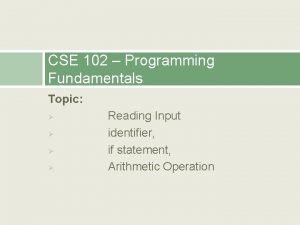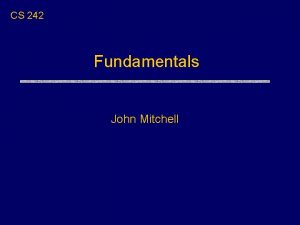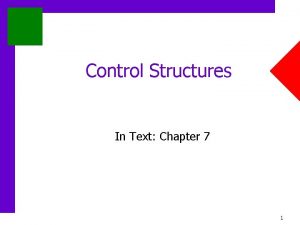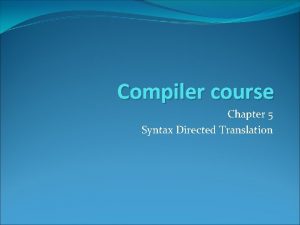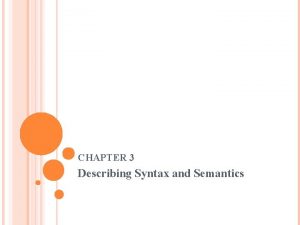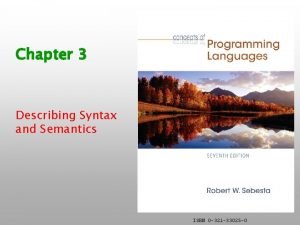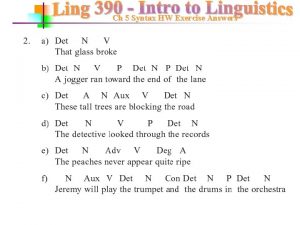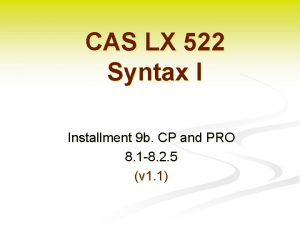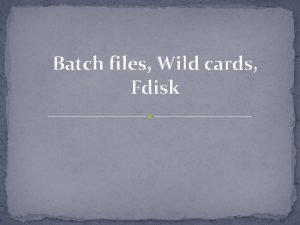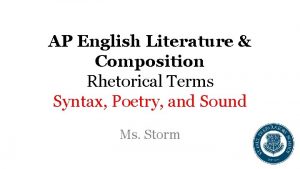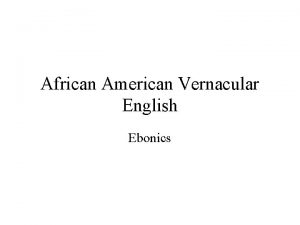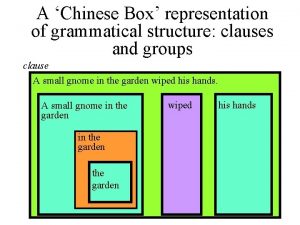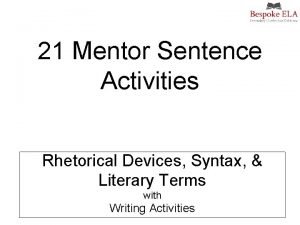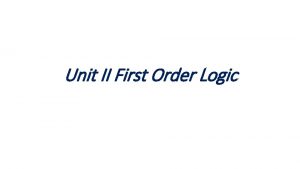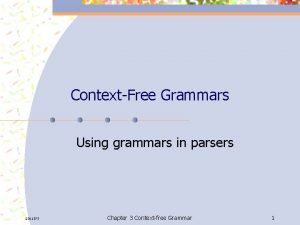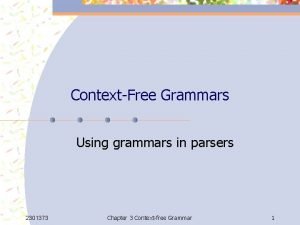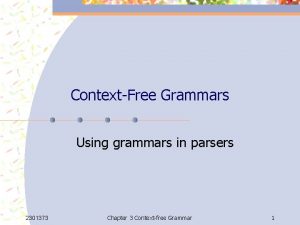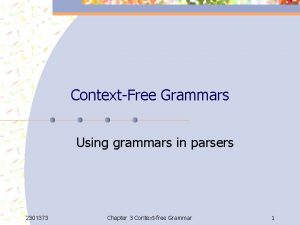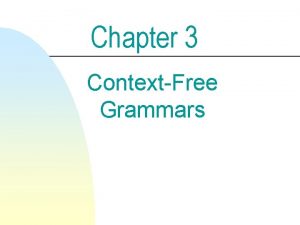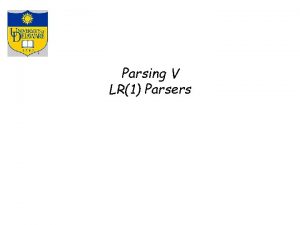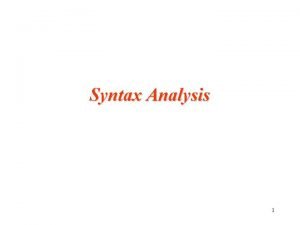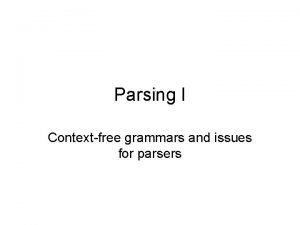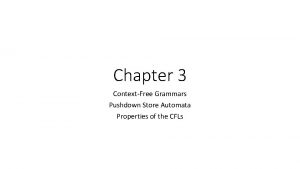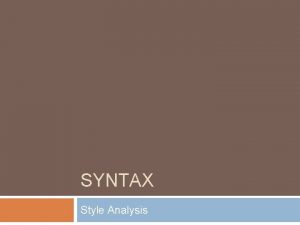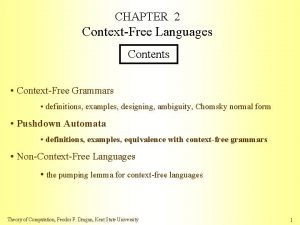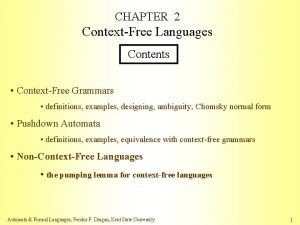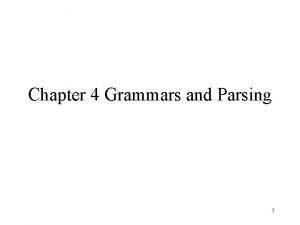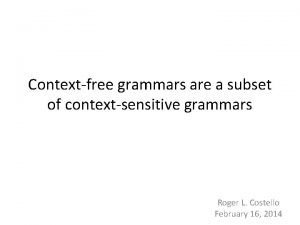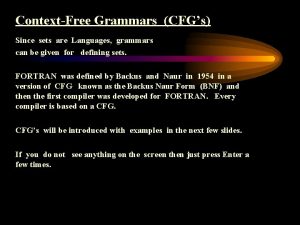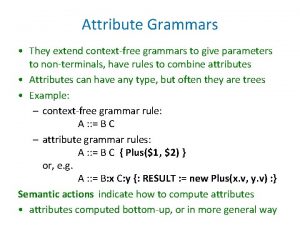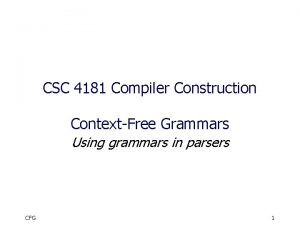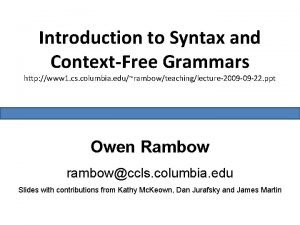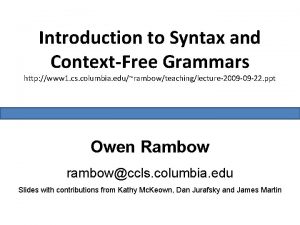Syntax Analysis Introduction to parsers Contextfree grammars Pushdown




![Notational Conventions in CFG • a, b, c, … [+-0 -9], id: symbols in Notational Conventions in CFG • a, b, c, … [+-0 -9], id: symbols in](https://slidetodoc.com/presentation_image/13e68b1758d58bb45a134b8ebdf49f65/image-5.jpg)








































![Types of CFG Parsers © Practical Parsers: [“what is a good parser? ”] © Types of CFG Parsers © Practical Parsers: [“what is a good parser? ”] ©](https://slidetodoc.com/presentation_image/13e68b1758d58bb45a134b8ebdf49f65/image-46.jpg)














![An Example type simple | id | array [ simple ] of type simple An Example type simple | id | array [ simple ] of type simple](https://slidetodoc.com/presentation_image/13e68b1758d58bb45a134b8ebdf49f65/image-61.jpg)
![An Example array [ num dotdot num ] of integer type array [ simple An Example array [ num dotdot num ] of integer type array [ simple](https://slidetodoc.com/presentation_image/13e68b1758d58bb45a134b8ebdf49f65/image-62.jpg)


















![An Example type simple | id | array [ simple ] of type simple An Example type simple | id | array [ simple ] of type simple](https://slidetodoc.com/presentation_image/13e68b1758d58bb45a134b8ebdf49f65/image-81.jpg)
![An Example Action Stack Input E type array [ num dotdot num ] of An Example Action Stack Input E type array [ num dotdot num ] of](https://slidetodoc.com/presentation_image/13e68b1758d58bb45a134b8ebdf49f65/image-82.jpg)




























- Slides: 110

Syntax Analysis © Introduction to parsers © Context-free grammars © Push-down automata © Top-down parsing © LL grammars and parsers © Bottom-up parsing © LR grammars and parsers © Bison/Yacc - parser generators © Error Handling: Detection & Recovery 1

Introduction to parsers CFG source Lexical code Analyzer token next token syntax Semantic Parser Analyzer tree Symbol Table 2

Context Free Grammar © CFG & Terminology © Rewrite vs. Reduce © Derivation © Language and CFL © Equivalence & CNF Derivation is the reverse of Parsing. If we know how sentences are derived, we may find a parsing method in the reversed direction. © Parsing vs. Derivation © lm/rm derivation & parse tree © Ambiguity & resolution © Expressive power 3

CFG: An Example © Terminals: id, ‘+’, ‘-’, ‘*’, ‘/’, ‘(’, ‘)’ © Nonterminals: expr, op © Productions: expr op expr ‘(’ expr ‘)’ expr ‘-’ expr id op ‘+’ | ‘-’ | ‘*’ | ‘/’ © The start symbol: expr 4
![Notational Conventions in CFG a b c 0 9 id symbols in Notational Conventions in CFG • a, b, c, … [+-0 -9], id: symbols in](https://slidetodoc.com/presentation_image/13e68b1758d58bb45a134b8ebdf49f65/image-5.jpg)
Notational Conventions in CFG • a, b, c, … [+-0 -9], id: symbols in • A, B, C, …, S, expr, stmt: symbols in N • U, V, W, …, X, Y, Z: grammar symbols in( +N) • a, b, g, …denotes strings in ( +N)* • u, v, w, … denotes strings in * • is an abbreviation of • Alternatives: a, b, … at RHS 5

Context-Free Grammars © A set of terminals: basic symbols from which sentences are formed © A set of nonterminals: syntactic variables denoting sets of strings © A set of productions: rules specifying how the terminals and nonterminals can be combined to form sentences © The start symbol: a distinguished nonterminal denoting the language 7

CFG: Components Specification for Structures & Constituency • CFG: formal specification of structure (parse trees) – G = { , N, P, S} – : terminal symbols – N: non-terminal symbols – P: production rules – S: start symbol 8

CFG: Components • : terminal symbols – the input symbols of the language • programming language: tokens (reserved words, variables, operators, …) • natural languages: words or parts of speech – pre-terminal: parts of speech (when words are regarded as terminals) • N: non-terminal symbols – groups of terminals and/or other non-terminals • S: start symbol: the largest constituent of a parse tree 9

CFG: Components • P: production (re-writing) rules – form: A → β (A: non-terminal, β: string of terminals and non-terminals) – meaning: A re-writes to (“consists of”, “derived into”)β, or β reduced to A – start with “S-productions” (S → β) 10

Derivations © A derivation step is an application of a production as a rewriting rule E -E © A sequence of derivation steps E - ( E ) - ( id ) is called a derivation of “- ( id )” from E © The symbol * denotes “derives in zero or more steps”; the symbol + denotes “derives in one or more steps 11

CFG: Accepted Languages • Context-Free Language – Language accepted by a CFG • L(G) = { | S + (strings of terminals that can be derived from start symbol)} – Proof of acceptance: by induction • On the number of derivation steps • On the length of input string 12

Context-Free Languages © A context-free language L(G) is the language defined by a context-free grammar G © A string of terminals is in L(G) if and only if S + , is called a sentence of G © If S * , where may contain nonterminals, then we call a sentential form of G E - ( E ) - ( id ) © G 1 is equivalent to G 2 if L(G 1) = L(G 2) 13

CFG: Equivalence • Chomsky Normal Form (CNF) (Chomsky, 1963): – ε-free, and – Every production rule is in either of the following form: • A → A 1 A 2 [two non-terminals: A 1, A 2], or • A→a [a terminal: a] – i. e. , two non-terminals or one terminal at the RHS • Properties: – Generate binary parse tree – Good simplification for some algorithms • e. g. , grammar training with the inside-outside algorithm (Baker 1979) – Good tool for theoretical proving • e. g. , time complexity 14

CFG: Equivalence • Every CFG can be converted into a weakly equivalent CNF – equivalence: L(G 1) = L(G 2) • strong equivalent: assign the same phrase structure to each sentence (except for renaming non-terminals) • weak equivalent: do not assign the same phrase structure to each sentence – e. g. , A → B C D == {A → B X, X → CD} 15

CFG: An Example © Terminals: id, ‘+’, ‘-’, ‘*’, ‘/’, ‘(’, ‘)’ © Nonterminals: E, op © Productions: E E op E …[R 1] E ‘(’ E ‘)’ …[R 2] E ‘-’ E …[R 3] E id …[R 4] op ‘+’ | ‘-’ | ‘*’ | ‘/’ © The start symbol: E 16

Left- & Right-most Derivations © Each derivation step needs to choose – a nonterminal to rewrite – an alternative to apply © A leftmost derivation always chooses the leftmost nonterminal to rewrite E lm - ( E ) lm - ( E + E ) lm - ( id + id ) © A rightmost (canonical) derivation always chooses the rightmost nonterminal to rewrite E rm - ( E ) rm - ( E + E ) rm - (E + id ) rm - ( id + id ) 17

Left- & Right-most Derivations © Representation of leftmost/rightmost derivations: © Use the sequence of productions (or production numbers) to represent a derivation sequence. R 2 R 1 © Example: © E rm - ( E ) rm - ( E + E ) rm - (E + id ) rm - ( id + id ) R 3 © => [3], [2], [1], [4] (~ R 3, R 2, R 1, R 4) © Advantage: A compact representation for parse tree (data compression) © Each parse tree has a unique leftmost/rightmost derivation 18

Parse Trees © A parse tree is a graphical representation for a derivation that filters out the order of choosing nonterminals for rewriting NP NP PP NP girl in the park 19

Context Free Grammar (CFG): Specification for Structures & Constituency • Parse Tree: graphical representation of structure – Root node (S): a sentencial level structure – Internal nodes: constituents of the sentence – Arcs: relationship between parent nodes and their children (constituents) – Terminal nodes: surface forms of the input symbols (e. g. , words) • Bracketed notation: Alternative representation • e. g. , [I saw [the [girl [in [the park]]]]] 20

Parse Tree: “I saw the girl in the park” S NP 1 st parse VP NP PP NP pron v det n p det n I saw the girl in the park 21

Parse Tree: “I saw the girl in the park” S NP 2 nd parse VP NP NP PP NP pron v det n p det n I saw the girl in the park 22

LM & RM: An Example E E lm - ( E ) lm - ( E + E ) lm - ( id + id ) E ( E ) E + E id id E rm - ( E ) rm - ( E + id ) rm - ( id + id ) 23

Parse Trees & Derivations © Many derivations may correspond to the same parse tree, but every parse tree has associated with it a unique leftmost and a unique rightmost derivation 24

Ambiguous Grammar © A grammar is ambiguous if it produces more than one parse tree for some sentence © more than one leftmost/rightmost derivation E E+E id + E * E id + id * id E E*E E+E*E id + E * E id + id * id 25

Ambiguous Grammar E E E + E id E * id E E id id E * E + E id id 26

Resolving Ambiguity © Use disambiguating rules to throw away undesirable parse trees © Rewrite grammars by incorporating disambiguating rules into unambiguous grammars 27

An Example © The dangling-else grammar stmt if expr then stmt | if expr then stmt else stmt | other © Two parse trees for if E 1 then if E 2 then S 1 else S 2 28

An Example S if E then if S E S if E then S S Preferred parse: closest then if else E S then S else S 29

Disambiguating Rules © Rule: match each else with the closest previous unmatched then © Remove undesired state transitions in the pushdown automaton (parser) © shift/reduce conflict on “else” © 1 st parse: reduce © 2 nd parse: shift 30

Grammar Rewriting stmt m_stmt | unm_stmt ; with only paired then-else So… cannot have unmatched then-else m_stmt if expr then m_stmt else m_stmt | other want this then-else pair matched unm_stmt if expr then stmt | if expr then m_stmt else unm_stmt 31

RE vs. CFG © Every language described by a RE can also be described by a CFG © Example: (a|b)*abb © A 0 a A 0 | b A 0 | a A 1 © A 1 b A 2 © A 2 b A 3 © A 3 (1) Right branching (2) Starts with a terminal symbol 32

RE vs. CFG A 0 a(|b) Regular Grammar: • Right branching • Starts with a terminal symbol A 0 a(|b) A 0 a A 1 b (a|b)* abb A 2 b A 3 33

RE vs. CFG A 0 a A 0 | b A 0 | a A 1 b A 2 RE: (a | b)*abb A 2 b A 3 a A 3 A 2 A 0 start 0 b a 1 A 1 b 2 b 3 A 3 34

RE vs. CFG a DFA for (a | b)*abb A 2 A 0 start b a 0 a b A 0 | a A 1 A 1 a A 1 | b A 2 a A 1 | b A 3 a A 1 | b A 0 | 1 b a 2 a b 3 A 3 35

CFG: Expressive Power (cont. ) • Writing a CFG for a FSA (RE) – define a non-terminal Ni for a state with state number i – start symbol S = N 0 (assuming that state 0 is the initial state) – for each transition δ(i, a)=j (from state i to stet j on input alphabet a), add a new production Ni → a Nj to P (if a== ε Ni → Nj) – for each final state i, add a new production Ni → εto P 36

CFG: Expressive Power • CFG vs. Regular Expression (R. E. ) – Every R. E. can be recognized by a FSA – Every FSA can be represented by a CFG with production rules of the form: →a. B|ε – (known as a “Regular Grammar”) A • Therefore, L(RE) L(CFG) 38

CFG: Expressive Power (cont. ) • Chomsky Hierarchy: – R. E. : Regular set (recognized by FSAs) – CFG: Context-free (Pushdown automata) – CSG: Context-sensitive (Linear bounded automata) – Unrestricted: Recursively enumerable (Tuning Machine) 39

Push-Down Automata Input a Stack (State info) Finite Automata d(s, a) Output Parsing table (Parsing actions) 40

RE vs. CFG © Why use REs for lexical syntax? – do not need a notation as powerful as CFGs – are more concise and easier to understand than CFGs – More efficient lexical analyzers can be constructed from REs than from CFGs – Provide a way for modularizing the front end into two manageable-sized components 41

CFG vs. Finite-State Machine • Inappropriateness of FSA – Constituents: only terminals – Recursion: do not allow A => … B … => … A … • RTN (Recursive Transition Network) – FSA with augmentation of recursion – arc: terminal or non-terminal – if arc is non-terminal: call to a sub-transition network & return upon traversal 42

Nonregular Constructs © REs can denote only a fixed number of repetitions or an unspecified number of repetitions of one given construct © E. g. a*b* © A nonregular construct: – L = {anbn | n 1} 43

Non-Context-Free Constructs © CFGs can denote only a fixed number of repetitions or an unspecified number of repetitions of one or two (paired) given constructs © E. g. anbn © Some non-context-free constructs: – L 1 = {wcw | w is in (a | b)*} • declaration/use of identifiers – L 2 = {anbmcndm | n 1 and m 1} • #formal arguments/#actual arguments – L 3 = {anbncn | n 0} • e. g. , b: Backspace, c: under score 44

Context-Free Constructs © FA (RE) cannot keep counts © CFGs can keep count of two items but not three © Similar context-free constructs: – L’ 1 = {wcw. R | w is in (a | b)*, R: reverse order} – L’ 2 = {anbmcmdn | n 1 and m 1} – L’’ 2 = {anbncmdm | n 1 and m 1} – L’ 3 = {anbn | n 1} 45

CFG Parsers 46

Types of CFG Parsers © Universal: can parse any CFG grammar © CYK, Earley © CYK: Exhaustively matching sub-ranges of input tokens against grammar rules, from smaller ranges to larger ranges © Earley: Exhaustively enumerating possible expectations from left-to-right, according to current input token and grammar © Non-universal: not all CFG’s can be parsed (e. g. , recursive descent parser) © Universal (to all grammars) is NOT always efficient 47
![Types of CFG Parsers Practical Parsers what is a good parser Types of CFG Parsers © Practical Parsers: [“what is a good parser? ”] ©](https://slidetodoc.com/presentation_image/13e68b1758d58bb45a134b8ebdf49f65/image-46.jpg)
Types of CFG Parsers © Practical Parsers: [“what is a good parser? ”] © Simple: simple program structure © Left-to-right (or right-to-left) scan © middle-out or island driven is often not preferred © Top-down or Bottom up matching © Efficient: efficient for good/bad inputs © Parse normal syntax quickly © Detect errors immediately on next token © Deterministic: © No alternative choices during parsing given next token © Small lookahead buffer (also contribute to efficiency) 48

Types of CFG Parsers © Top Down: © Matching from start symbol down to terminal tokens © Bottom Up: © Matching input tokens with reducible rules from terminal up to start symbol 49

Efficient CFG Parsers © Top Down: LL Parsers © Matching from start symbol down to terminal tokens, left-to-right, according to a leftmost derivation sequence © Bottom Up: LR Parsers © Matching input tokens with reducible rules, left-to-right, from terminal up to start symbol, in a reverse order of rightmost derivation sequence 50

Efficient CFG Parsers © Efficient & Deterministic Parsing – only possible for some subclasses of grammars with special parsing algorithms © Top Down: ©Parsing LL Grammars with LL Parsers © Bottom Up: ©Parsing LR Grammars with LR Parsers ©LR grammar is a larger class of grammars than LL 51

Parsing Table Construction for Good parsers do not Efficient Parsers change their codes when the grammar is revised. Table driven. © Parsing Table: © A pre-computed table (according to the grammar), indicating the appropriate action(s) to take in any predefined state when some input token(s) is/are under examination © Lookahead symbol(s): the input symbol(s) under examination for determining next id + * num action(s) State-0 action-1 State-2 action-3 action-2 action-5 action-4 52

Parsing Table Construction for Efficient Parsers © Parsing Table Construction: © Decide a pre-defined number of lookaheads to use for predicting next state © Define and enumerate all the unique states for the parsing method © Decide the actions to take in all states with all possible lookahead(s) 53

Parsing Table Construction for Efficient Parsers © X-Parser: you can invent any parser and call it the X-Parser © But its parsing algorithm may not handle all grammars deterministically, thus efficiently. © X-Grammar: © Any grammar whose parsing table for the Xparsing method/X-Parser has no conflicting actions in all states © Non-X Grammar: has more than one action to take under any state 54

Parsing Table Construction for Efficient Parsers © k: The number of lookahead symbols used by a parser to determine the next action © A larger number of lookahead symbols tends to make it less possible to have conflicting actions © But may result in a much larger table that grows exponentially with the number of lookaheads © Does not guarantee unambiguous for some grammars (inherently ambiguous) even with infinite lookaheads © X(k) Parser: © X Parser that uses k lookahead symbols to determine the next action © X(k) Grammar: © any grammar deterministically parsable with X(k) Parser 55

Types of Grammars Capable of Efficient Parsing © LL(k) Grammars © Grammars that can be deterministically parsed using an LL(k) parsing algorithm © e. g. , LL(1) grammar © LR(k) Grammars © Grammars that can be deterministically parsed using an LR(k) parsing algorithm © e. g. , SLR(1) grammar, LALR(1) grammar 56

Top-Down CFG Parsers Recursive Descent Parser vs. Non-Recursive LL(1) Parser 57

Top-Down Parsing © Construct a parse tree from the root to the leaves using leftmost derivation S c. AB A ab|a B d input: cad S S c A B a b a a d 58

Predictive Parsing © A top-down parsing without backtracking – there is only one alternative production to choose at each derivation step stmt if expr then stmt else stmt | while expr do stmt | begin stmt_list end 59

LL(k) Parsing © The first L stands for scanning the input from left to right © The second L stands for producing a leftmost derivation © The k stands for the number of input symbols for lookahead used to choose alternative productions at each derivation step 60

LL(1) Parsing © Use one input symbol of lookahead ©Same as Recursive-descent parsing © But, Non-recursive predictive parsing 61

Recursive Descent Parsing (more) © The parser consists of a set of (possibly recursive) procedures © Each procedure is associated with a nonterminal of the grammar © The calling sequence of procedures in processing the input implicitly defines a parse tree for the input 62
![An Example type simple id array simple of type simple An Example type simple | id | array [ simple ] of type simple](https://slidetodoc.com/presentation_image/13e68b1758d58bb45a134b8ebdf49f65/image-61.jpg)
An Example type simple | id | array [ simple ] of type simple integer | char | num dotdot num 63
![An Example array num dotdot num of integer type array simple An Example array [ num dotdot num ] of integer type array [ simple](https://slidetodoc.com/presentation_image/13e68b1758d58bb45a134b8ebdf49f65/image-62.jpg)
An Example array [ num dotdot num ] of integer type array [ simple ] num dotdot num of type simple integer 64

An Example procedure type; begin if lookahead is in { integer, char, num } then simple else if lookahead = id then match(id) else if lookahead = array then begin match(array); match('['); simple; match(']'); match(of); type end else error end; 65

An Example procedure match(t : token); begin if lookahead = t then lookahead : = nexttoken else error end; 66

An Example procedure simple; begin if lookahead = integer then match(integer) else if lookahead = char then match(char) else if lookahead = num then begin match(num); match(dotdot); match(num) end else error end; 67

LL(k) Constraint: Left Recursion © A grammar is left recursive if it has a nonterminal A such that A + A A A | A R A A R R R| R R R * A 68

Direct/Immediate Left Recursion A A 1 | A 2 |. . . | A m | 1 | 2 |. . . | n A A i | j (i=1, m ; j=1, n) A 1 A' | 2 A' |. . . | n A' is equivalent to … A' 1 A' | 2 A' |. . . | m A' | ( 1 | 2 |. . . | n ) ( 1 | 2 |. . . | m )* 69

An Example E E + T | T T T * F | F F ( E ) | id E T E' E' + T E' | T F T' T' * F T' | F ( E ) | id 70

Indirect Left Recursion G 0: S A a | b A Ac|Sd| Problem: Indirect Left-Recursion: S Aa Sda • Scan rules top-down • Do not start with symbols defined earlier (=> substitute them if any) • Resolve direct recursion Solution-Step 1: Indirect to Direct Left-Recursion: A Ac|Aad|bd| Solution-Step 2: Direct Left-Recursion to Right. Recursion: S Aa|b A b d A' | A' 71

Indirect Left Recursion Input. Grammar G with no cycles or -production. Output. An equivalent grammar with no left recursion. 1. Arrange the nonterminals in some order A 1, A 2, . . . , An 2. for i : = 1 to n do begin // Step 1: Substitute 1 st-symbols of Ai for j : = 1 to i - 1 do begin // which are previous Aj’s replace each production of the form Ai Aj ( j < i ) by the production Ai 1 | 2 |. . . | k where Aj 1 | 2 |. . . | k are all the current Aj-productions; end eliminate direct left recursion among Ai-productions // Step 2 end 72

Left Factoring © Two alternatives of a nonterminal A have a nontrivial common prefix if , and A 1 | 2 A A' A' 1 | 2 73

An Example S i. Et. S|i. Et. Se. S|a E b S i E t S S' | a S' e S | E b 74

Top-Down Parsing: as Stack Matching © Construct a parse tree from the root to the leaves using leftmost derivation S c. AB A ab|a B d input: cad S S c A B a b a a d 76

Nonrecursive Predictive Parsing – General State a b c … x y z Input Stack X Non. Recursive: “Stack + Driver Program” (instead of Recursive procedures) … Parsing program (parser/driver) Parsing table Output M[X, a]= {X -> Y 1 Y 2 … Y k} Predictive: precomputed parsing actions 77

Nonrecursive Predictive Parsing – Expand Non-terminal a b c … x y z Input Stack Y 1 Non. Recursive: “Stack + Driver Program” (instead of Recursive procedures) Y 2 … Yk Parsing program (parser/driver) Parsing table Output M[X, a]= {X -> Y 1 Y 2 … Y k} Predictive: precomputed parsing actions 78

Nonrecursive Predictive Parsing – Match Terminal a Stack Y 1 Non. Recursive: “Stack + Driver Program” (instead of Recursive procedures) b c … x y z Input =a Y 2 … Yk Parsing program (parser/driver) Parsing table Output M[X, a]= {X -> Y 1 Y 2 … Y k} Predictive: precomputed parsing actions 79

Nonrecursive Predictive Parsing - Error Recovery a Stack Y 1 =a Y 2 =c Non. Recursive: “Stack + Driver Program” (instead of Recursive procedures) … Yk b c … x y Parsing program (parser/driver) Parsing table z Input Output M[X, a]= {X -> Y 1 Y 2 … Y k} Predictive: precomputed parsing actions 80

Nonrecursive Predictive Parsing - Error Recovery a Stack Y 1 =a Y 2 =c Non. Recursive: “Stack + Driver Program” (instead of Recursive procedures) … Yk b c … x y Parsing program (parser/driver) Parsing table z Input Output M[X, a]= {X -> Y 1 Y 2 … Y k} Predictive: precomputed parsing actions 81

Stack Operations © Match – when the top stack symbol is a terminal and it matches the input symbol, pop the top stack symbol and advance the input pointer © Expand – when the top stack symbol is a nonterminal, replace this symbol by the right hand side of one of its productions • Leftmost RHS symbol at Top-of-Stack 83

Stack Operations © Match – when the top stack symbol is a terminal and it matches the input symbol, pop the top stack symbol and advance the input pointer © Expand – when the top stack symbol is a nonterminal, replace this symbol by the right hand side of one of its productions • Leftmost RHS symbol at Top-of-Stack u. Error Recovery (optional) 84
![An Example type simple id array simple of type simple An Example type simple | id | array [ simple ] of type simple](https://slidetodoc.com/presentation_image/13e68b1758d58bb45a134b8ebdf49f65/image-81.jpg)
An Example type simple | id | array [ simple ] of type simple integer | char | num dotdot num 85
![An Example Action Stack Input E type array num dotdot num of An Example Action Stack Input E type array [ num dotdot num ] of](https://slidetodoc.com/presentation_image/13e68b1758d58bb45a134b8ebdf49f65/image-82.jpg)
An Example Action Stack Input E type array [ num dotdot num ] of integer M type of ] simple [ [ num dotdot num ] of integer E type of ] simple num dotdot num ] of integer M type of ] num dotdot num ] of integer M type of ] ] of integer M type of of integer E type integer E simple integer 86 M integer

Parsing program push $S onto the stack, where S is the start symbol ($: end-of-input) set ip to point to the first symbol of w$; // try to match S$ with w$ repeat let X be the top stack symbol and a the symbol pointed to by ip; if X is a terminal or $ then if X = a then // Match pop X from the stack and advance ip else error // or Error_Recovery() else // X is a nonterminal: Expand (lookup parsing table M[X, a]) if M[X, a] = X Y 1 Y 2. . . Yk then pop X from and push Yk. . . Y 2 Y 1 onto the stack else error // or Error_Recovery() until X = $ 87

Parser Driven by a Parsing Table: Non-recursive Descent a b X X Y 1 Y 2 … Yk X Z 1 Z 2 … Zm Y 1 1 c d Y 1 2 Z 1 b 1 Z 1 b 2 X() { // WITHOUT ε-production: X→ε if (LA=‘a’) then Y 1(); Y 2(); …Yk(); else if (LA=‘b’) ‘a’ in First. Set( Y 1 Y 2 … Yk ) ‘b’ in First. Set( Z 1 Z 2 … Zm ) Z 1(); Z 2(); …; Zm(); else ERROR(); // no X→ε // else RETURN; // if X exists } // Recursive decent procedure for matching X 88

Parser Driven by a Parsing Table: Non-recursive Descent a b c d X X Y 1 Y 2 … Yk X Z 1 Z 2 … Zm (? ) X Y 1 1 Y 1 2 Z 1 b 1 Z 1 b 2 X() { // WITH ε-production: X→ε if (LA=‘a’) then Y 1(); Y 2(); …Yk(); else if (LA=‘b’) ‘a’ in First. Set( Y 1 Y 2 … Yk ) ‘b’ in First. Set( Z 1 Z 2 … Zm ) Z 1(); Z 2(); …; Zm(); // else ERROR(); // no X→ε else RETURN; // if X exists } // Recursive decent procedure for matching X 89

Parser Driven by a Parsing Table: Non-recursive Descent: LL(1) a b X X Y 1 Y 2 … Yk X Z 1 Z 2 … Zm Y 1 1 c d X Y 1 2 Z 1 b 1 Z 1 b 2 X() { // WITH ε-production: X→ε if (LA=‘a’) then Y 1(); Y 2(); …Yk(); else if (LA=‘b’) ‘a’ in First. Set( Y 1 Y 2 … Yk ) ‘b’ in First. Set( Z 1 Z 2 … Zm ) ‘d’ in Follow. Set(X) (S =>* …X d …) Z 1(); Z 2(); …; Zm(); // else ERROR(); // no X→ε else if (LA=? ? ) RETURN; // if X exists } // Recursive decent procedure for matching X 90

First Sets: Predictive Parsing © The first set of a string is the set of terminals that begin the strings derived from . © If * , then is also in the first set of . ©Used simply to flag whether can be null for computing First Set ©Not for matching any real input when parsing © FIRST( ) = {a | * a }+{ , if * } © FIRST( ) includes { }: means that * 91

Compute First Sets © If X is terminal, then FIRST(X) is {X} © If X is nonterminal and X is a production, then add to FIRST(X) © If X is nonterminal and X Y 1 Y 2. . . Yk is a production, then add a to FIRST(X) if for some i, a is in FIRST(Yi) and is in all of FIRST(Y 1), . . . , FIRST(Yi-1). ©If is in FIRST(Yj) for all j, then add to FIRST(X) 92

Follow Sets: Matching Empty © What to do with matching null: A ? © TD Recursive Descent Parsing: “assumes” success © LL Parser: more predictive/restrictive © => only when input, a, is in Follow Set of ‘A’ © The follow set of a nonterminal A is the set of terminals that can appear immediately to the right of A in some sentential form, namely, S * A a a is in the follow set of A. 93

Compute Follow Sets © Initialization: Place $ in FOLLOW(S), where S is the start symbol and $ is the input right end marker. © If there is a production A B , then everything in FIRST( ) except for is placed in FOLLOW(B) © is not considered a visible input to follow any symbol © If there is a production A B or A B where FIRST( ) contains (i. e. , * ), then everything in FOLLOW(A) is in FOLLOW(B) © S * … A a … implies S * … B a … © YES: “every symbol that can follow A will also follow B” © NO!: “every symbol that can follow B will also follow A” 94

An Example E T E' E' + T E' | T F T' T' * F T' | F ( E ) | id FIRST(E) = FIRST(T) = FIRST(F) = { (, id } FIRST(E') = { +, } FIRST(T') = { *, } FOLLOW(E) = FOLLOW(E') = { ), $ } FOLLOW(T) = FOLLOW(T') = { +, ), $ } FOLLOW(F) = { +, *, ), $ } 95

Constructing Parsing Table Input. Grammar G. Output. Parsing Table M. Method. 1. For each production A of the grammar, do steps 2 and 3. 2. For each terminal a in FIRST( ), add A to M[A, a]. 3. If is in FIRST( ) [A * ], add A to M[A, b] for each terminal b [including ‘$’] in FOLLOW(A). - If is in FIRST( ) and $ is in FOLLOW(A), add A to M[A, $]. 4. Make each undefined entry of M be error. 96

LL(1) Parsing Table Construction a in First( ) A A B C including A b in Follow(A) c not in First( ) or Follow(A) A ( * ) error When to apply A ? A() { // WITH/WITHOUT ε-productions: A ( * ) if (LA=‘a’ in First(Y 1 Y 2… Yk)) then Y 1(); Y 2(); …Yk(); else if (LA=‘b’ in Follow(A) & εin First(Z 1 Z 2. . . )) Z 1(); Z 2(); …; Zm(); // Nullable else ERROR(); } // Recursive version of LL(1) parser 97

An Example E T E' E' + T E' | T F T' T' * F T' | F ( E ) | id FIRST(E) = FIRST(T) = FIRST(F) = { (, id } FIRST(E') = { +, } FIRST(T') = { *, } FOLLOW(E) = FOLLOW(E') = { ), $ } FOLLOW(T) = FOLLOW(T') = { +, ), $ } FOLLOW(F) = { +, *, ), $ } 98

An Example id + * ( ) $ E E TE' E' E' +TE' E' E' T T FT' T' *FT' T' T' F F id F (E) 99

An Example Stack $E $E'T'F $E'T'id $E'T' $E'T+ $E'T'F $E'T'id $E'T'F* $E'T'F $E'T'id $E'T' $E' $ Input id + id * id$ + id * id$ id * id$ id$ $ $ $ Output E TE' T FT' F id T' E' + TE' T FT' F id T' * FT' F id T' E' 100

LL(1) Grammars © A grammar is an LL(1) grammar if its predictive parsing table has no multiplydefined entries 101

A Counter Example S i E t S S' | a S' e S | E b e FOLLOW(S’) a S S a S' E b e S' S' e S Disambiguation: matching closest “then” i t S i E t S S' $ S' e FIRST(e S) 102

LL(1) Grammars or Not ? ? © A grammar G is LL(1) iff whenever A | are two distinct productions of G, the following conditions hold: – For no terminal a do both and derive strings beginning with a. • or… M[A, first( )&first(b)] entries will have conflicting actions – At most one of and can derive the empty string • or… M[A, follow(A)] entries have conflicting actions – If * , then does not derive any string beginning with a terminal in FOLLOW(A). • or… M[A, first( )&follow(A)] entries have conflicting actions 103

Non-LL(1) Grammar: Ambiguous According to LL(1) Parsing Table Construction a in First( ) & First(b) A A A b b in Follow(A) A ( * ) A b ( * ) a in First( ) & Follow(A) A (/ * ) (but * a g) A b ( * ) B C When will A & A b appear in the same table cell ? ? X Xa |b S' e S | 104

LL(1) Grammars or Not? ? © If G is left-recursive or ambiguous, then M will have at least one multiply-defined entry © => non-LL(1) © E. g. , X X a | b © => FIRST(X) = {b} (and, of course, FIRST(b) = {b}) © => M[X, b] includes both {X X a} and {X b} © i. e. , Ambiguous G and G with left-recursive productions can not be LL(1). © No LL(1) grammar can be ambiguous 105

Error Recovery for LL Parsers 106

Syntactic Errors • Empty entries in a parsing table: – Syntactic error is encountered when the lookahead symbol corresponding to this entry is in input buffer – Error Recovery information can be encoded in such entries to take appropriate actions upon error • Error Detection: – (1) Stacktop = x && x != input (a) – (2) Stacktop = A && M[A, a] = empty (error) 107

Error Recovery Strategies © Panic mode: skip tokens until a token in a set of synchronizing tokens appears © INS (insertion) type of errors © sync at delimiters, keywords, …, that have clear functions © Phrase Level Recovery © local INS (insertion), DEL (deletion), SUB (substitution) types of errors © Error Production © define error patterns (“error productions”) in grammar © Global Correction [Grammar Correction] © minimum distance correction 108

Error Recovery – Panic Mode © Panic mode: skip tokens until a token in a set of synchronizing tokens appears © Commonly used Synchronizing tokens: – SUB(A, ip): use FOLLOW(A) as sync set for A (pop A) – use the FIRST set of a higher construct as sync set for a lower construct – INS(ip): use FIRST(A) as sync set for A – *ip= : use the production deriving as the default – DEL(ip): If a terminal on stack cannot be matched, pop the terminal 109

Error Recovery – Panic Mode Action SUB(A, ip) … A *ip … A Follow(A) … INS(ip) … A *ip … First(A) … A x *ip … … DEL(ip) Stack Input … x X … A *ip X … … Follow(A)… X A *ip … First(A)… … x 110 *ip

Error Recovery Actions Using Follow & First Sets to Sync © Expanding non-terminal A: © M[A, a] = error (blank): © Skip “a” in input © = delete all such “a” (until sync with sync symbol, b) /* panic */ © M[A, b] = sync (at FOLLOW(A)) © Pop “A” from stack © = “b” is a sync symbol following A © M[A, b] = A (== sync at FIRST(A) ) © Expand A as (same as normal parsing action) © Matching terminal “x”: © (*sp=“x”) != “a” © Pop(x) from stack © = missing input token “x” 111

FOLLOW(X) is used to Expand productions or Sync (on errors) An Example E E' T T' F FOLLOW(E)=FOLLOW(E’)={), $ } id + * ( ) $ E TE' sync E' +TE' E' E' T FT' sync T' T' *FT' T' T' F id sync F (E) sync FOLLOW(F)={+, *, ), $} FIRST(X) is used to Expand non- productions or Sync (on errors) 112

An Example Stack $E $E $E'T'F $E'T'id $E'T'F* $E'T'F $E'T' $E'T+ $E'T'F $E'T'id $E'T' $E' $ Input ) id * + id$ id * + id$ + id$ id$ $ $ $ Output error, skip ) id is in FIRST(E) E TE' T FT' F id T' *FT' error, M[F, +]=synch / FOLLOW(F) F popped T' E' +TE' T FT' F id T' E' 113

Parse Tree - Error Recovered ) id * + id => id * F + id E ) T F T’ E’ T + id * F T’ ε E’ F T’ ε id ε 114
 Which of the following parsers is the most powerful ?
Which of the following parsers is the most powerful ? Unrestricted grammer
Unrestricted grammer Handling questions in context-free grammars
Handling questions in context-free grammars Every linear grammar generates a regular language
Every linear grammar generates a regular language Eliminating useless symbols
Eliminating useless symbols Chomsky hierarchy of grammars
Chomsky hierarchy of grammars Syntax directed translation
Syntax directed translation Syntax analyzer source code in java
Syntax analyzer source code in java Two stack pushdown automata
Two stack pushdown automata Pushdown automata
Pushdown automata Pushdown automata adalah
Pushdown automata adalah Pushdown accounting
Pushdown accounting Pda to cfg
Pda to cfg Pushdown automata implementation
Pushdown automata implementation Pushdown automata implementation
Pushdown automata implementation Push down automata adalah
Push down automata adalah Csci 3130
Csci 3130 Nondeterministic pushdown automata
Nondeterministic pushdown automata Pda reminder 1
Pda reminder 1 Pda language
Pda language Automata
Automata Pushdown automata
Pushdown automata Pushdown automata
Pushdown automata Automata
Automata Introduction syntax
Introduction syntax Simple and complex words examples
Simple and complex words examples Syntax analysis in compiler design
Syntax analysis in compiler design Syntax analysis english
Syntax analysis english Sintaks adalah
Sintaks adalah Lexical and syntax analysis
Lexical and syntax analysis Define syntax analysis
Define syntax analysis Dr
Dr Syntactic features
Syntactic features Pairwise disjointness test example
Pairwise disjointness test example Syntax analysis
Syntax analysis Syntax analysis generator
Syntax analysis generator Lexical and syntax analysis
Lexical and syntax analysis Intro paragraph layout
Intro paragraph layout Xml usage
Xml usage Dtd syntax
Dtd syntax Syntax vety
Syntax vety Didls language
Didls language Use case syntax
Use case syntax Understanding soap
Understanding soap Probability syntax
Probability syntax Probability syntax
Probability syntax Sophisticated diction example
Sophisticated diction example Vertikalne clenenie textu
Vertikalne clenenie textu Syntax and semantics
Syntax and semantics Syntax vs grammar
Syntax vs grammar Syntax rules definition
Syntax rules definition Syntax symbols and meanings
Syntax symbols and meanings Diction and syntax
Diction and syntax Syntax
Syntax Syntax error handling
Syntax error handling Syntax directed defination
Syntax directed defination Syntax vs semantics
Syntax vs semantics Syntax in the things they carried
Syntax in the things they carried Switch statement syntax
Switch statement syntax Repeated measures anova spss
Repeated measures anova spss Grammar vs syntax vs semantics
Grammar vs syntax vs semantics Syntax vety priklady
Syntax vety priklady Syntax vs semantic
Syntax vs semantic Syntax vs semantics
Syntax vs semantics Inverted syntax
Inverted syntax Syntax and grammar
Syntax and grammar Pseudo code syntax
Pseudo code syntax Java main method syntax
Java main method syntax Operation expression
Operation expression Nlp syntax
Nlp syntax What is the syntax
What is the syntax Middle english words
Middle english words What is syntax literary device
What is syntax literary device Morphology definition linguistics
Morphology definition linguistics Syntax rules
Syntax rules What is syntax?
What is syntax? Assembly language instruction
Assembly language instruction Syntax vs semantic
Syntax vs semantic Parsing syntax
Parsing syntax Nepravidelnost vetnej stavby
Nepravidelnost vetnej stavby Linear and hierarchical structure linguistics
Linear and hierarchical structure linguistics Syntax and grammar
Syntax and grammar Differences between morphology and syntax
Differences between morphology and syntax Syntax tree diagram adverb phrase
Syntax tree diagram adverb phrase Algol syntax
Algol syntax Html 5 syntax
Html 5 syntax Patterns of diction
Patterns of diction Patterns of diction
Patterns of diction English syntax and argumentation
English syntax and argumentation X bar theory exercises
X bar theory exercises Early modern english syntax
Early modern english syntax Syntax xml
Syntax xml Diction vs syntax
Diction vs syntax Diction and syntax
Diction and syntax Negative diction
Negative diction The man sighed hugely
The man sighed hugely Define syntax in programming
Define syntax in programming Cse 102
Cse 102 Syntax vs semantics
Syntax vs semantics Algol syntax
Algol syntax Evaluation orders for sdd's in compiler design
Evaluation orders for sdd's in compiler design General problem of describing semantics in ppl
General problem of describing semantics in ppl Syntax vs semantics
Syntax vs semantics Answers
Answers Is because a complementizer
Is because a complementizer Fdisk syntax
Fdisk syntax Is alliteration syntax
Is alliteration syntax Aave syntax
Aave syntax Chinese boxes syntax
Chinese boxes syntax Fair is foul and foul is fair literary device
Fair is foul and foul is fair literary device First order logic syntax
First order logic syntax
